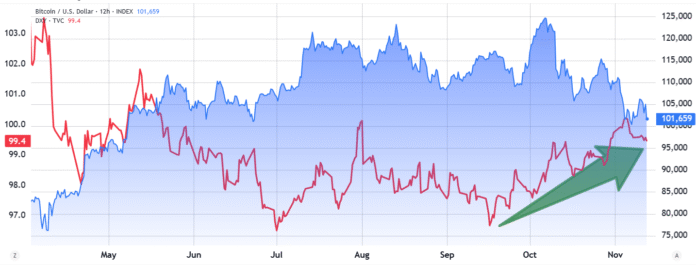Bitcoin’s Struggle to Overcome Resistance Levels: 3 Key Factors
Bitcoin (BTC) has been facing significant challenges in overcoming resistance levels, particularly the $106,000 mark, despite the S&P 500 being close to a new all-time high. The cryptocurrency’s price has been influenced by various factors, including the strengthening US dollar, concerns about quantum computing, and a shift in investor interest towards privacy-focused coins. In this article, we will explore three key reasons why Bitcoin is struggling to overcome each new overhead resistance level.
The recent rise in the US Dollar Index (DXY) against a basket of major currencies has reflected renewed confidence in the US Treasury’s ability to address its fiscal challenges. This has resulted in a stronger dollar, which often has an inverse correlation with the Bitcoin price. Meanwhile, the US stock market tends to benefit from a stronger dollar and lower interest rates, making it more challenging for Bitcoin to gain traction.
Source: TradingView / Cointelegraph
Companies’ Bitcoin Reserve Strategies and the Impact on Price
Companies pursuing Bitcoin reserve strategies, such as MicroStrategy (MSTR) and Metaplanet (MTPLF), have been among the biggest corporate buyers to date. However, the recent downturn in the cryptocurrency market has largely wiped out the advantage of issuing shares, removing the incentive for companies to issue additional shares. At current price levels, any new issue would dilute existing shareholders, making it an unattractive option without a significant mNAV premium.
Source: BitcoinTreasuries.Net
These companies can still raise funds through debentures or convertible notes, but such financing is typically less advantageous to investors. Debtors often demand collateral, which effectively reduces the amount of Bitcoin that goes into a company’s enterprise value, limiting potential mNAV growth.
Long-Term Holders Selling and Growing Interest in Privacy-Focused Coins
Investor fears intensified after long-term Bitcoin holders, including those from 2018 or earlier, began selling amid a 20% decline from the all-time high of $126,220. One high-profile case is believed to involve Owen Gunden, an arbitrage trader from the era of the failed Japanese exchange Mt. Gox, who reportedly owns more than $1 billion worth of Bitcoin.
Last week alone, Owen transferred more than 1,800 BTC worth over $200 million to the Kraken exchange. While it is not uncommon to see long-dormant addresses move funds, traders are wondering whether these transactions reflect waning long-term confidence, especially given growing concerns about quantum resistance and strong rallies in privacy-focused cryptocurrencies.
Zcash (ZEC) is up 99% in the last 30 days, followed by a 74% increase in Decred (DCR), a 37% increase in Dash (DASH), and a 22% increase in Monero (XMR). Despite net inflows into Bitcoin spot exchange-traded funds (ETFs) of $524 million on Tuesday, buyer sentiment remains subdued, meaning the likelihood of BTC reaching $112,000 in the near term is relatively low.
Selling by long-time Bitcoin holders, continued US dollar strength, and growing interest in privacy-focused tokens are overall slowing Bitcoin’s recovery, keeping prices below $106,000 and signaling that significant upside potential may remain limited. For more information, visit https://cointelegraph.com/news/3-reasons-why-bitcoin-struggles-to-overcome-each-new-overhead-resistance-level?utm_source=rss_feed&utm_medium=rss_category_market-analysis&utm_campaign=rss_partner_inbound

